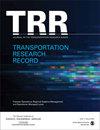使用Twitter来衡量加拿大卡尔加里公交服务重大变化的客户满意度
IF 1.8
4区 工程技术
Q3 ENGINEERING, CIVIL
引用次数: 1
摘要
衡量公众对公交服务质量的看法是理解和解决顾客不满、提高顾客忠诚度和客流量的关键因素。使用社交媒体(尤其是twitter)进行情绪分析是对传统调查方法的一种相对便宜且潜在强大的补充,传统调查方法昂贵且样本量有限。本研究旨在评估客户对引入卡尔加里运输公司MAX航线的反应。我们比较了在Twitter上表达的客户满意度和以准时表现形式衡量的服务可靠性。我们还采用了一种定性研究方法,利用Twitter的内容分析来衡量乘客在服务改变前后对几个服务属性的满意度。使用混合方法开发了过境特定情绪词典来支持这项研究。该词典在准确性(18.4%)和f1得分(7.1%)方面都优于转运研究中传统使用的一般情感词典。我们发现,使用Twitter的乘客对准点率的总体看法与现场的实际表现相似。这也被观察到在一个单独的路线上,不遵守时间表的站点与负面反馈有关。这项研究的结论是,将Twitter上以客户为导向的措施与以运营为导向的措施相结合,将使交通机构能够为规划和运营目的做出更明智的决策。本文章由计算机程序翻译,如有差异,请以英文原文为准。
Using Twitter to Gauge Customer Satisfaction Response to a Major Transit Service Change in Calgary, Canada
Measuring public opinion about the quality of transit services is a key factor in understanding and addressing customer dissatisfaction and increasing customer loyalty and ridership. Sentiment analysis using social media—in particular Twitter—is a relatively cheap and potentially powerful complement to traditional survey methods, which are expensive and limited in sample size. This study aims to evaluate customer response to the introduction of Calgary Transit’s MAX routes. We compared customer satisfaction expressed on Twitter with measured service reliability in the form of on-time performance. We also employed a qualitative research approach using content analysis from Twitter to gauge rider satisfaction over several service attributes before and after the service change. A transit-specific sentiment lexicon was developed to support this study using a hybrid approach. This lexicon outperformed generic sentiment lexicons traditionally used in transit studies with regard to both accuracy (18.4%) and F1-score (7.1%). We found that the overall perception of on-time performance from riders using Twitter was similar to the actual performance in the field. This was also observed for one individual route on which stops with poor schedule adherence were linked with negative feedback. This study concludes that combining customer-oriented measures from Twitter with operational-oriented ones would enable transit agencies to make better-informed decisions for planning and operational purposes.
求助全文
通过发布文献求助,成功后即可免费获取论文全文。
去求助
来源期刊

Transportation Research Record
工程技术-工程:土木
CiteScore
3.20
自引率
11.80%
发文量
918
审稿时长
4.2 months
期刊介绍:
Transportation Research Record: Journal of the Transportation Research Board is one of the most cited and prolific transportation journals in the world, offering unparalleled depth and breadth in the coverage of transportation-related topics. The TRR publishes approximately 70 issues annually of outstanding, peer-reviewed papers presenting research findings in policy, planning, administration, economics and financing, operations, construction, design, maintenance, safety, and more, for all modes of transportation. This site provides electronic access to a full compilation of papers since the 1996 series.
 求助内容:
求助内容: 应助结果提醒方式:
应助结果提醒方式:


